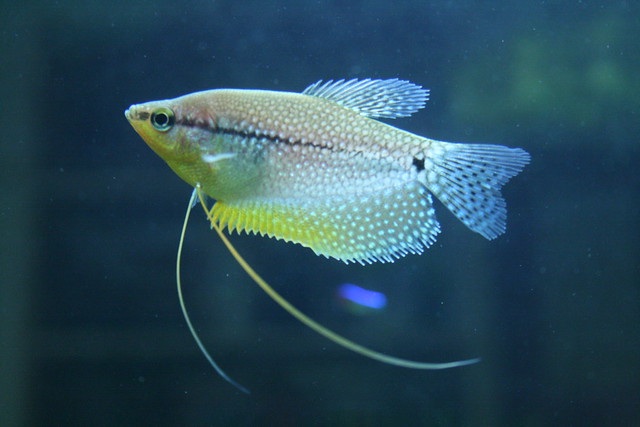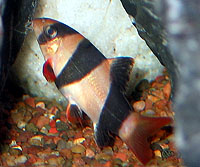(Original title: Keeping the Pearl Gourami in Aquariums)
 |
| Photo by h080 |
The Pearl Gourami , Trichogaster leeri, is also called the Lace Gourami, Diamond Gourami and the Mosaic Gourami, and sometimes the Red Breasted Gourami. It is native to Thailand, Malaysia and Indonesia. It has been introduced to Colombia, The Philippines and Taiwan.
, Trichogaster leeri, is also called the Lace Gourami, Diamond Gourami and the Mosaic Gourami, and sometimes the Red Breasted Gourami. It is native to Thailand, Malaysia and Indonesia. It has been introduced to Colombia, The Philippines and Taiwan.
Length and Longevity
It can grow to about 12 centimetres (4 1/2 inches) long. It will live for up to 8 years.
Water Conditions
This fish comes from tropical countries, and it needs warm water. A temperature of between 24 and 28 degrees C (75- 83 degrees F) is suitable. They come from soft acid water, but the adults are moderately adaptable and a pH of between 6.0 and 7.5 with a dH of up to 19 is all right for maintaining them.
Plants
This fish comes from still or sluggishly moving water bodies with a lot of plants in, so at least part of their aquarium needs to have a lot of plants. Ideally these should include floating plants.
Breathing
The Pearl Gourami is a labyrinth fish and can breathe air as well as water, so it needs access to the air. It is better if the air is of a similar temperature to the water and is humid, so the tank should be well covered.
Food
This fish is an easily fed omnivore. It will eat all common fish foods. Its diet should include foods of both animal origin like live or frozen bloodworms, daphnia or brine shrimp, and also things a vegetable origin like algae wafers, lettuce or lightly cooked zucchini.
Hydra
Although the most popular fish for eating Hydra is the Blue Gourami , Pearl Gouramis also eat it readily. They are smaller and more peaceful than Blue Gouramis and are sometimes kept in tanks as small as 60 Litres (15 US gallons), so there are circumstances where the Pearl Gourami would be the fish of choice to get rid of hydra.
, Pearl Gouramis also eat it readily. They are smaller and more peaceful than Blue Gouramis and are sometimes kept in tanks as small as 60 Litres (15 US gallons), so there are circumstances where the Pearl Gourami would be the fish of choice to get rid of hydra.
Bruising
The Pearl Gourami has a soft body and care needs to be taken when handling this fish.
Companions
It is a very peaceful fish which is often, but not always, shy. It can safely be put with fish smaller than itself although I would not put it with fish as small as Neon Tetras, but most of the more peaceful tetras are suitable companions as well as all the corydoras catfish like the Bronze Catfish.
You need to avoid fish that nip fins or are large and aggressive.
Steve Challis has many other fish fact sheets and other articles on http://www.bettatrading.com.au including pictures and breeding information about the Pearl Gourami at http://www.bettatrading.com.au/Pearl-Gourami-Fact-Sheet.php. Article Source: EzineArticles |









